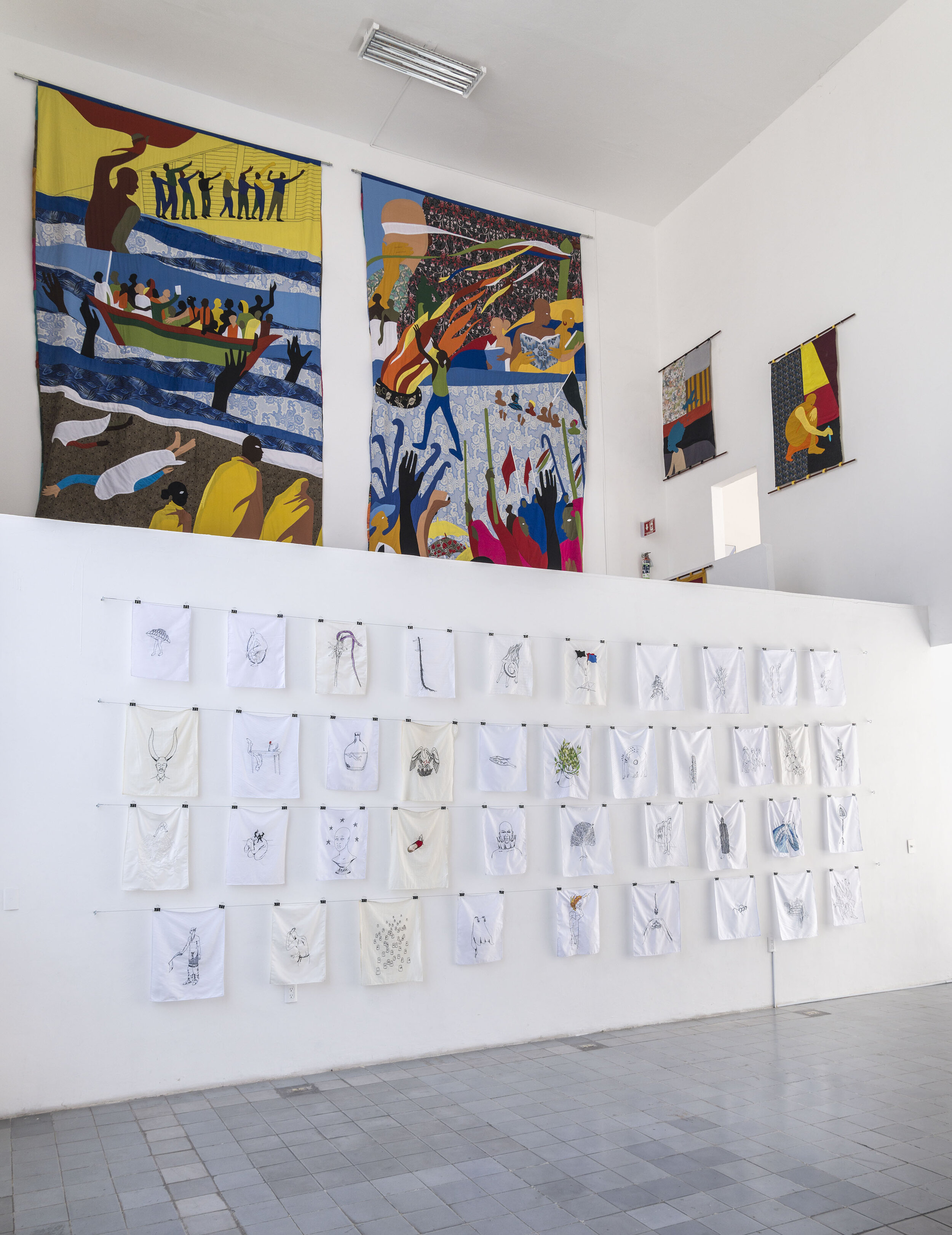Christopher Myers: Flags of No Nation
Solo Exhibition | Feb. 4-March 11, 2017
TMR Guadalajara | PAOS | Museo Taller José Clemente Orozco
This is a past exhibition.
For his first institutional solo show in Latin America, Christopher Myers presents two bodies of work that explore ideas of migration and belonging.
About the Exhibition.
An accomplished artist and writer based in New York, Myers has been committed for years to transforming our understanding of globalization and the multiple realities it creates. Through his work and practice Myers draws our attention to the shortcomings of intellectual disciplines struggling to make sense of our world order and asks us to look beyond the failing metrics we use to quantify the textured dimensions of our networked society. In doing so, Myers brings into focus a richly interwoven set of critical intimacies; quotidian actions through which globalization is embodied, articulated, performed, and made tactic. These moments, worldly in nature but scaled in personhood, are where Myers sites the lived consequences of broader geopolitical, economic, social, and cultural mechanics.
For his exhibition at TMR Guadalajara Myers presents two bodies of work that explore the construction of contested visualities—image landscapes that take shape when multiple languages are forged into shared pictures. The first body of work, titled I Am Not a Human Being, was produced through a collaboration between Myers and a group of Vietnamese embroiders who would sow with him as they occasionally listened to Lil’ Wayne songs. The linguistic complexity of Weezy’s lyrics, masked in the simplicity of his puns, was visualized into images stich by stich—giving way to a codex of signs and symbols grounded in cultural specificity yet fluid enough to provoke varying meanings from viewers who encounter them. The second body of work, Vxllrncgnt, takes the Asafo flags made by the Fante people of Ghana as a point of departure. These flags, which give figurative life to the proverbs or sayings endemic to the Asafos, or social/military clubs, trace their origins back to European colonial rule when Western nations used flags to project their power and domination; composing stories of Empire with colors and icons. Mobilizing the function of these flags as repositories of narratives both real and imaginary, Myers has created two monumental banner works with his collaborators in Egypt. These works, loaded with images that blend the reality of our time with hopeful specters, are flags for nations that are yet to be.
Distinct in certain ways, these two bodies of work both grapple with a simple human act—our ability to envision or imagine. In Myers’s work, the process of translating language to image; of traveling between the discursive and the pictorial, is like disassembling a palimpsest—showing us how the histories and experiences of those who came before us are inevitably carried on through the actions we enact upon the world. As embroiderers in Saigon make pictures from the words vocalized in Weezy’s “How to Love,” or tapestry makers in Luxor assemble textile parchments into figures, the visions they give us are filled with gentle disturbances—the head of an African-American man outlined off-scale because it was perhaps embroidered by someone whose only seen black bodies in YouTube videos or an orange-toned arm, meant to be brown, stitched onto a tapestry as such because trade agreements make certain dyes difficult to access. These consequential subtleties that Myers shows us are where the global is made real and graspable; where we come to know that even our most basic actions are tied to processes that exist beyond ourselves. The ability to incite this realization is where the agency of Myers’s works is found—where he makes us deeply conscious that what we do as individuals inevitably affects the way that worlds are made.
About the Artist.
Christopher Myers (b. 1974, US) is an artist and writer based in New York. While he is widely acclaimed for his work authoring and illustrating literature for young people, he is also an artist and maker whose work has been included in a host of exhibitions and cultural projects around the world. Myers has collaborated with traditional shadow puppet makers in Jogjakarta, silversmiths in Khartoum, conceptual video artists in Vietnam, musicians in New Orleans, woodcarvers in Accra, weavers in Luxor, and many other artists who he sees as all being part of a large conversation about the movement of culture. Myers’s collaborations are fueled by an interest in the way that languages are borrowed globally and traded from South to South in order to address specific local concerns of people that have been thrust into contexts that range far beyond their locality. Myers’s work has been exhibited at PS1/MoMA, the Art Institute of Chicago, Prospect Biennial in New Orleans, and Contrasts Gallery in Shanghai. Myers has also curated exhibitions in Vietnam, designed theater that has travelled from PS122 in New York City to the Genocide Memorial Theater in Kigali, Rwanda, and collaborated with artist Hank Willis Thomas on a short film, Am I Going Too Fast, which premiered at Sundance. Myers participated in the Whitney Independent Studio Program. He has also written a host of essays for exhibition catalogues and for publication such as The New York Times. He is currently working on a book comparing global censorship methodologies.
Credits
Christopher Myers: Flags of No Nation is organized by TMR in collaboration with PAOS and curated by Cesar Garcia, TMR Director and Chief Curator.
TMR's program is made possible with the support of its Board of Directors, Big Mistake Patron Group, International Council, and Contemporary Council.
Support for TMR Guadalajara is provided by Colección Dieresis and Jose Noe Suro.
In-kind support is provided by Cerveza Ventura.
Photo Credit: Cary Whittier. Copyright 2016. The Mistake Room Inc.








